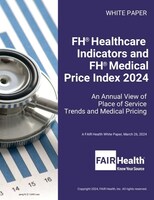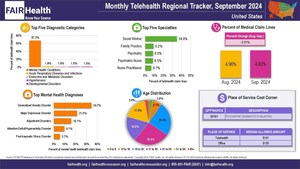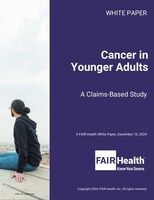Retail Clinic Utilization Increased 202 Percent Nationally from 2021 to 2022, according to Seventh Annual FAIR Health Report
Emergency Room Utilization Increased 138 Percent Nationally from 2021 to 2022
NEW YORK, March 26, 2024 /PRNewswire/ -- Retail clinic utilization increased 202 percent nationally from 2021 to 2022, and emergency room (ER) utilization increased 138 percent.1 Retail clinics and ERs had the greatest increases in utilization among the places of service studied—which also included urgent care centers, telehealth and ambulatory surgery centers (ASCs)—in a new FAIR Health white paper containing the seventh annual edition of FH® Healthcare Indicators and FH® Medical Price Index. Like the previous editions, this year's edition of FH Healthcare Indicators and FH Medical Price Index is intended to provide perspective for all healthcare stakeholders in a rapidly changing healthcare environment.
FH Healthcare Indicators
FH Healthcare Indicators reveal trends and patterns in the places where patients receive healthcare. Focusing on alternative places of service and ERs, FH Healthcare Indicators evaluate changes in utilization, geographic and demographic factors, diagnoses, procedures and costs.
Among the other key findings:
- ASC utilization increased 88 percent nationally from 2021 to 2022; urgent care center utilization increased 43 percent and telehealth 8 percent in the same period.
- ER services accounted for 4.2 percent of all medical claim lines nationally in 2022, the highest percentage among the places of service studied. Telehealth accounted for 3.9 percent of medical claim lines, urgent care centers 2.1 percent, ASCs 1.1 percent and retail clinics 0.2 percent. The remainder of the services were rendered in traditional places of service, such as physician offices.
- In 2022, as in previous years, more claim lines were submitted for females than males in most age groups in these alternative places of service and ERs.
- In 2022, New York was one of the top five states for use of urgent care centers and telehealth, as measured by the percentage of medical claim lines accounted for by those places of service, but it was not among the top five states for retail clinics.
- In 2022, COVID-19 remained on the list of most common diagnostic categories in retail clinics, urgent care centers, telehealth and ERs (for individuals over the age of 22). However, COVID-19 diagnoses rose in the rankings of retail clinics and telehealth, fell in those of ERs and stayed the same in those of urgent care centers.
- Across offices, urgent care centers and retail clinics in 2022, the highest median allowed amount for CPT® 2 99204 (new patient office or other outpatient visit, 45-59 minutes) was in offices at $183, while the median allowed amount for urgent care centers was $174 and for retail clinics $149.
FH Medical Price Index
FH Medical Price Index reports shifts in costs and facilitates useful comparisons among medical prices in six procedure categories from May 2012 to November 2023:
- Professional evaluation and management (E&M; excluding E&Ms performed in a hospital setting);
- Hospital E&M (excluding E&Ms performed in a professional setting, such as typical office visits);
- Medicine (excluding E&Ms);
- Surgery (procedures for which the physician would bill);
- Pathology and laboratory (including both technical and professional components, e.g., both equipment and professional services); and
- Radiology (including both technical and professional components).
The reports reflect professional fees and related costs; they do not include facility fees.
For the period November 2022 to November 2023:
- In the charge amount index, professional E&Ms and medicine each increased five percent, the greatest percent increase in the six procedure categories. The pathology and laboratory charge amount index increased four percent, while the surgery charge amount index increased three percent.
- Hospital E&Ms and radiology each increased one percent, the smallest percent increase in charge amount index.
- In the allowed amount index, professional E&Ms and hospital E&Ms each increased three percent. The pathology and laboratory allowed amount index grew two percent, while the medicine and surgery allowed amount indices each increased one percent.
- Radiology was the only category to have a decrease in allowed amount index, four percent.
FAIR Health President Robin Gelburd stated: "We hope that this new edition of FH Healthcare Indicators and FH Medical Price Index, like those in previous years, continues to inform decision making by payors, providers, government officials, policy makers, academic researchers and the general public."
For the new white paper, FH® Healthcare Indicators and FH® Medical Price Index 2024: An Annual View of Place of Service Trends and Medical Pricing, click here.
Follow us on X @FAIRHealth
About FAIR Health
FAIR Health is a national, independent nonprofit organization that qualifies as a public charity under section 501(c)(3) of the federal tax code. It is dedicated to bringing transparency to healthcare costs and health insurance information through data products, consumer resources and health systems research support. FAIR Health possesses the nation's largest collection of private healthcare claims data, which includes over 45 billion claim records and is growing at a rate of over 3 billion claim records a year. FAIR Health licenses its privately billed data and data products—including benchmark modules, data visualizations, custom analytics and market indices—to commercial insurers and self-insurers, employers, providers, hospitals and healthcare systems, government agencies, researchers and others. Certified by the Centers for Medicare & Medicaid Services (CMS) as a national Qualified Entity, FAIR Health also receives data representing the experience of all individuals enrolled in traditional Medicare Parts A, B and D, which accounts for a separate collection of over 47 billion claim records; FAIR Health includes among the private claims data in its database, data on Medicare Advantage enrollees. FAIR Health can produce insightful analytic reports and data products based on combined Medicare and commercial claims data for government, providers, payors and other authorized users. FAIR Health's systems for processing and storing protected health information have earned HITRUST CSF certification and achieved AICPA SOC 2 Type 2 compliance by meeting the rigorous data security requirements of these standards. As a testament to the reliability and objectivity of FAIR Health data, the data have been incorporated in statutes and regulations around the country and designated as the official, neutral data source for a variety of state health programs, including workers' compensation and personal injury protection (PIP) programs. FAIR Health data serve as an official reference point in support of certain state balance billing laws that protect consumers against bills for surprise out-of-network and emergency services. FAIR Health also uses its database to power a free consumer website available in English and Spanish, which enables consumers to estimate and plan for their healthcare expenditures and offers a rich educational platform on health insurance. An English/Spanish mobile app offers the same educational platform in a concise format and links to the cost estimation tools. The website has been honored by the White House Summit on Smart Disclosure, the Agency for Healthcare Research and Quality (AHRQ), URAC, the eHealthcare Leadership Awards, appPicker, Employee Benefit News and Kiplinger's Personal Finance. For more information on FAIR Health, visit fairhealth.org.
Contact:
Rachel Kent
Executive Director of Communications and Marketing
FAIR Health
646-396-0795
[email protected]
1 Utilization in this study is a relative, normalized measure, not an absolute one. See Methodology section of the white paper.
2 CPT © 2023 American Medical Association (AMA). All rights reserved.
SOURCE FAIR Health

WANT YOUR COMPANY'S NEWS FEATURED ON PRNEWSWIRE.COM?
Newsrooms &
Influencers
Digital Media
Outlets
Journalists
Opted In







Share this article